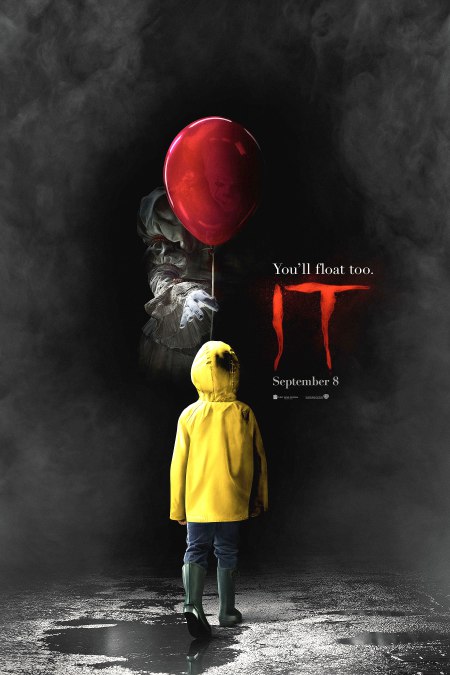All Play and No Work Makes IT a Dull Movie
September 20, 2017
The 2017 screen adaption of Stephen King’s classic horror novel IT hit theaters on September 8th, scaring off the competition with an initial weekend box office gross of $123.1 million domestically (internationally, IT has surpassed $371 million in ticket sales). And, in theory, fans aren’t spending their money in vain; IT has an impressive viewer rating of 8.0 on IMDb, with more than 90,000 votes. But how much does the Warner Bros. film actually accomplish when it comes to its content, story, visuals, and production? Does IT have the caliber to stand beside other outstanding monster movies, or will IT’s “Pennywise the Dancing Clown” simply disappear from fans’ minds shortly after they leave the theater?
The answer seems nearly as scattered as the remains of the missing children within the film.
IT (technically titled IT: Chapter 1) takes place in the small town of Derry, Maine, from the fall of 1988 to the summer of 1989. A group of middle school children self-described as the “Loser’s Club” disobey the words and wishes of their overbearing and abusive parents to investigate a series of strange disappearances in their town, discovering and then surviving encounter after encounter with “It”, a monster that shapeshifts into whatever it feels its victims most fear (for the film, “It” most often takes the form of “Pennywise the Dancing Clown”, a form adapted by the film’s writers from parts of Stephen King’s original novel). After a chilling storyline of death and betrayal, the Loser’s Club finally defeats Pennywise together in a final battle in which the children learn not to fear Pennywise or any other form he takes, forcing “It” back into hiding for another 27-year-long hibernation. The film ends with the children taking a blood oath to return if “It” does, an adventure apparently setting the stage for IT: Chapter 2.
The screenplay and story line of IT is quite exceptional and admittedly, there are numerous powerful and defining elements (even beyond horror) that shine through, elements that deserve attention and discussion. And the mood and overall direction that IT takes is – at least in theory – as horrifyingly brilliant as the classic films that preceded it. But the real horror, however, stems from the film’s abhorrent use of CGI (computer generated images).
Each variation that “It” morphs into is constructed using poorly executed and laughable visual effects (except for the form of Pennywise, who is expertly played by Swedish actor Bill Skarsgård). The use of such immature computer graphics paired with an otherwise adept and skillfully mature actor highlights the most blatant flaw in director Andy Muschietti’s vision: the mishandling of an exceptional screenplay, ultimately resulting in cinematic mediocrity.
This on screen mediocrity is like a cancer that infests an otherwise enjoyable film. A scene in which Beverly Marsh (played by Sophia Lillis) is trapped in her bathroom while a wave of blood unexpectedly and terrifyingly gushes out of the sink is a horror concept that hasn’t truly presented itself in movies since the blood elevator scene from Stanley Kubrick’s The Shining; but while such a powerful yet delicate scene was masterfully shot by visionary cinematographers for Kubrick’s masterpiece, boring angles and amateur techniques work to nearly ruin the same idea in IT. Many scenes in the movie succumb to this setback: sitting in the theater, I couldn’t help but imagine the potential that IT could have had if the film hadn’t been shot like a B movie.
Because while IT is executed mostly unimaginatively, the script, acting, and cinematic themes rival some of even the best horror films of our time – which makes its mediocrity in terms of production especially tragic.
On the surface, IT is a terrifying tale about children fending off a monster, Pennywise being the antagonist that drives the plot. But the genius of IT lies not in its mystery but in plain sight: the film centers itself not on the terror of an evil clown, but rather the horror of growing up.
The true monsters of IT are the grown ups of Derry and the classmates of our protagonists. Pennywise, in effect, is used as a symbolic object to force a coming of age upon the Loser’s Club, a temporary device to help unify the children against a world of seemingly permanent savagery. This is abstractly suggested throughout the film: Eddie Kaspbrak, who is convinced by his mother to be suffering from numeral fake diseases, sees It as a sickening leper; Stanley Uris, who is oppressed by his strict Jewish father, sees It as a terrifying figure from a painting that hangs in their synagogue; and Beverly Marsh, in the most clear representation of this device, sees It as her father, who sexually abuses her.
Consequently, when It is finally defeated and Pennywise sinks back into the depths, the audience knows that the real triumphs are the victories in the children’s personal lives. Being bonded by their teamwork and collective heart they set back out into the world with a new confidence, and though it’s unclear whether or not It will return, what is certain is the children of the Loser’s Club won’t fear monsters any longer. IT is less of a monster slayer and more of a narrative on rites of passage and coming of age.
But generally the movie shies away from regular horror tropes and delivers on a basic level. IT isn’t really scary, per se; rather it’s reminiscent of the nostalgic feeling of being scared, reminding you what it felt like as a child to be truly terrified of something that wasn’t real. It’s not Pennywise himself that frightens us, but rather the idea of Pennywise that keeps us on the edge of our seats. That, and the jump scares.
IT: Chapter 1 is a good abridged version of Stephen King’s novel, with clever story pieces and powerful themes, but it is unfortunately middlingly executed and produced with sub-par attention, tragically resulting in a largely passable film. Walking out of the theater, I felt like I had just seen a movie akin to The Shining… if The Shining was directed and produced by David Hasselhoff.
IT is not a bad movie, but unfortunately, that’s all it is:
Not bad.
Shak’s rating: 6.5/10






Gabe • Nov 2, 2017 at 8:45 am
This article really changed the way I think about It. Not just this one, but all horror movies. Love the David Hasslehoff comment though.
Shuk • Sep 21, 2017 at 3:54 pm
Great article!
It intrigues me to watch a movie now.
souria • Sep 20, 2017 at 11:16 pm
Very well-written article! I saw this movie twice back to back and I would have to agree on the point you made about the graphics but I would disagree on the overall rating. I thought the movie presented a lot of comic relief all while a clown murdering children was lurking. Fun and scary movie!